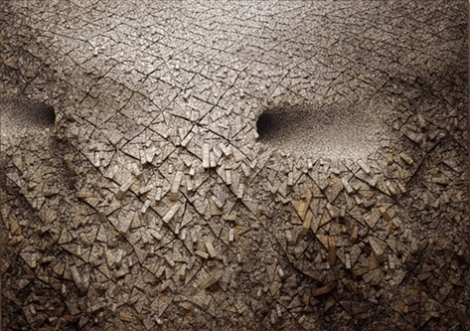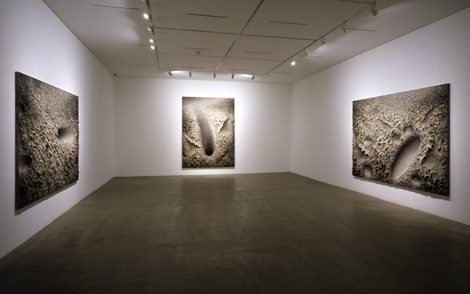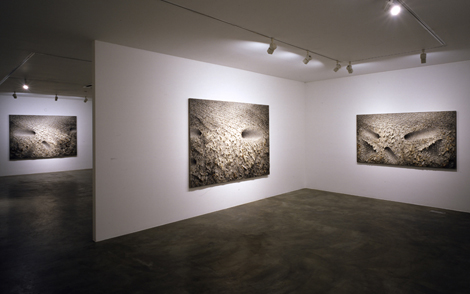 Aggregation 2005 | KUKJE GALLERY
Aggregation 2005 | KUKJE GALLERY

Oct 15, 2005 - Dec 18, 2005
K1
Seoul
INTRODUCTION
Chun, Kwang-Young has been using Korean mulberry paper or “hanji” in place of paint since early 1990s to produce the series titled Aggregation. The basic concept of Chun’s works is drawn from Korea’s culture as well as the artist’s personal experience. Chun’s involvement with Korean mulberry paper hanji began at an early age. The young Chun saw triangular-shaped bundles of hanji-wrapped oriental medicines hung from the ceiling of his herbal doctor uncle’s house. Chun’s nostalgic memory of his early childhood transcended to be reborn as works of art reflecting both traditional beauty of the old days and today’s modern style.
Although Korean in its concept and the use of materials, Chun’s works echo Western art in his method of expression. Chun creates a painterly yet relief-like work by wrapping triangular-shaped Styrofoam with hanji, which is then tied with knotted hanji rope and dyed with natural extract, and assembling each unit on a wood frame. More than thousands of cells are assembled to create a pictorial plane. Chun’s painterly canvas is simple and abstract with pre-designed arrays of triangular cells in varying shades. In addition, the triangular cells appear as a relief-like work.
Chun’s work is very much in line with the practice of Concept Art that emphasized the structuring of an idea and/or a concept as the most important aspect of an artwork. The visual representation of Chun’s finished work arises much imagination from a viewer; however, Chun’s basic idea and concept for his work ‘wrapping’ and ‘assembling’ provide greater meaning.
In this exhibition, Chun will introduce his most recent body of works. Chun has employed more dynamic movements by applying various sizes and shades of triangular units. As such, the works sometimes look like craters when seen up-close, and sometimes they create a Milky Way when seen from afar.
Born in Hongchoen, Kwangwon Province in 1944, Chun, Kwang-Young has a B.A. in Fine Art from Hong-ik University’s painting department and a M.A. from Philadelphia School of Art. In 2001, he received the prestigious artist of the year award from the National Museum of Contemporary Art, Korea. Chun has held numerous solo and group exhibitions at prominent galleries and museums such as Columbus Museum in Columbus, Georgia and the Contemporary Museum in Honolulu, Hawaii
1960년대 후반부터 1990년대 초반까지 회화 위주의 작업을 해오던 작가 전광영은 1995년 한지를 유화를 대신하는 매체로 도입하여 ‘집합’이라는 연작을 만들어 내면서 자신만의 독특한 작품 세계를 구축해오고 있다. 작가는 평면의 나무 프레임 안에 한지로 싼 수천 개의 삼각형 스티로폼을 한지로 꼬아 만든 끈으로 묶어 집결시킴으로써 회화적이면서도 부조(relief) 같은 작품을 만들어 낸다. 작가의 최근작들은 각기 다른 크기와 다른 명암의 삼각형 쎌들이 집합되면서 사각 평면 안에서의 불규칙적 움직임을 이룸으로써 규칙적인 틀의 파괴를 표현하고 있다.
전광영 작품의 기본적 개념은 한국의 문화적 정서뿐만 아니라 작가의 개인적 경험과 아주 밀접한 관계를 갖는다. 한지는 한국을 대표하는 문화적인 요소의 하나로 오래 전부터 대중의 일상생활에 많이 사용되었던 재료이다. 오래 전부터 한지는 서예나 책 등 문화적인 사용뿐 아니라 집안의 창문, 문, 벽지 및 물건 포장용 등 일상의 생활 재료로 이용되어 왔다. 한지의 내구성과 영구성은 이런 다양한 목적으로 사용되는데 있어 중요한 특질을 제공하며, 이러한 한지의 특수성은 이웃나라이면서 종이 제작의 창시 국가인 중국마저도 극찬할 정도이다. 이렇듯 한국을 대표하는 재료인 한지와 전광영의 관계는 작가의 개인적 경험에 의해 시작된다. 그는 어릴 적 한의사였던 큰아버지 댁을 자주 왕래하면서 삼각형 형태로 늘어져 천정에 매달려 있던 한지 약 봉투를 보게 된다. 한지 종이봉투에 얽힌 그의 향수 어린 기억이 오늘날 고전적인 아름다움과 현대적인 스타일을 고루 갖춘 작품으로 승화된 것이다.
전광영이 작품에 사용하는 재료나 작품의 기본적 개념은 매우 한국적이지만 그의 작품에 나타나는 표현 방식에서는 서양미술의 영향을 엿볼 수 있다. 작가는 1970년대를 미국에서 보내면서 접한, 당시 미국 미술계를 휩쓸었던 미술사조인 미니멀 아트 또는 개념미술의 영향을 받았다. 식물이나 차 등 자연적 요소에서 추출해낸 색조로 물들여진 한지 쎌들이 하나하나 나열되어 명암의 차이로 인해 배출되는 회화적인 면은 오히려 아주 단순하게 추상화되어 있다. 또 한지 단위들은 기본적인 삼각형 모양으로 배열되면서 부조 같은 성격을 드러낸다. 개념미술의 핵심이 작품에서 가장 중요한 부분은 아이디어와 개념의 구축에 있다고 할 때 전광영의 작품은 이러한 생각에 매우 가깝다고 볼 수 있다. 완성된 작품 자체에서 보이는 외부적인 면 또한 보는 이에게 많은 상상력을 불러 일으키지만, 그 내면에 내재된 작품에 대한 작가의 기본적인 아이디어와 개념인 ‘싸기’(wrapping)와 ‘집성’(assembling)은 작품에 한층 더 깊은 의미를 제공한다.
이번 국제갤러리에서는 작가의 최근작들을 소개한다. 이번에 소개되는 신작들은 그 크기에서나 더욱 부각된 명암의 강약으로 이전보다 한층 역동성을 띠고 있으며 이를 통해 작가의 열정과 야심을 엿볼 수 있다. 그의 작품들은 캔버스 안에 표현된 명암의 변화로 인해 작품을 가까이에서 보면 마치 분화구 같기도 하고 멀리서 바라보면 은하계를 보고 있는 듯한 느낌을 준다. 이전의 한지 작품들이 정서적인 고요함을 표현했다면 이번에 새로 선보이는 작품들은 보다 다이내믹한 운동감을 보여준다. 이번 전시에서는 또한 작가의 거대한 조각 작품 한 점이 소개된다. ‘심장’을 표현한 이 조각품을 통해 관객들은 한정된 사각이라는 프레임 안에 갇혀 있는 부조적 작품에서 나아가 한층 더 넓은 공간으로 침투하는 전광영의 작품세계를 만날 수 있다.
Although Korean in its concept and the use of materials, Chun’s works echo Western art in his method of expression. Chun creates a painterly yet relief-like work by wrapping triangular-shaped Styrofoam with hanji, which is then tied with knotted hanji rope and dyed with natural extract, and assembling each unit on a wood frame. More than thousands of cells are assembled to create a pictorial plane. Chun’s painterly canvas is simple and abstract with pre-designed arrays of triangular cells in varying shades. In addition, the triangular cells appear as a relief-like work.
Chun’s work is very much in line with the practice of Concept Art that emphasized the structuring of an idea and/or a concept as the most important aspect of an artwork. The visual representation of Chun’s finished work arises much imagination from a viewer; however, Chun’s basic idea and concept for his work ‘wrapping’ and ‘assembling’ provide greater meaning.
In this exhibition, Chun will introduce his most recent body of works. Chun has employed more dynamic movements by applying various sizes and shades of triangular units. As such, the works sometimes look like craters when seen up-close, and sometimes they create a Milky Way when seen from afar.
Born in Hongchoen, Kwangwon Province in 1944, Chun, Kwang-Young has a B.A. in Fine Art from Hong-ik University’s painting department and a M.A. from Philadelphia School of Art. In 2001, he received the prestigious artist of the year award from the National Museum of Contemporary Art, Korea. Chun has held numerous solo and group exhibitions at prominent galleries and museums such as Columbus Museum in Columbus, Georgia and the Contemporary Museum in Honolulu, Hawaii
1960년대 후반부터 1990년대 초반까지 회화 위주의 작업을 해오던 작가 전광영은 1995년 한지를 유화를 대신하는 매체로 도입하여 ‘집합’이라는 연작을 만들어 내면서 자신만의 독특한 작품 세계를 구축해오고 있다. 작가는 평면의 나무 프레임 안에 한지로 싼 수천 개의 삼각형 스티로폼을 한지로 꼬아 만든 끈으로 묶어 집결시킴으로써 회화적이면서도 부조(relief) 같은 작품을 만들어 낸다. 작가의 최근작들은 각기 다른 크기와 다른 명암의 삼각형 쎌들이 집합되면서 사각 평면 안에서의 불규칙적 움직임을 이룸으로써 규칙적인 틀의 파괴를 표현하고 있다.
전광영 작품의 기본적 개념은 한국의 문화적 정서뿐만 아니라 작가의 개인적 경험과 아주 밀접한 관계를 갖는다. 한지는 한국을 대표하는 문화적인 요소의 하나로 오래 전부터 대중의 일상생활에 많이 사용되었던 재료이다. 오래 전부터 한지는 서예나 책 등 문화적인 사용뿐 아니라 집안의 창문, 문, 벽지 및 물건 포장용 등 일상의 생활 재료로 이용되어 왔다. 한지의 내구성과 영구성은 이런 다양한 목적으로 사용되는데 있어 중요한 특질을 제공하며, 이러한 한지의 특수성은 이웃나라이면서 종이 제작의 창시 국가인 중국마저도 극찬할 정도이다. 이렇듯 한국을 대표하는 재료인 한지와 전광영의 관계는 작가의 개인적 경험에 의해 시작된다. 그는 어릴 적 한의사였던 큰아버지 댁을 자주 왕래하면서 삼각형 형태로 늘어져 천정에 매달려 있던 한지 약 봉투를 보게 된다. 한지 종이봉투에 얽힌 그의 향수 어린 기억이 오늘날 고전적인 아름다움과 현대적인 스타일을 고루 갖춘 작품으로 승화된 것이다.
전광영이 작품에 사용하는 재료나 작품의 기본적 개념은 매우 한국적이지만 그의 작품에 나타나는 표현 방식에서는 서양미술의 영향을 엿볼 수 있다. 작가는 1970년대를 미국에서 보내면서 접한, 당시 미국 미술계를 휩쓸었던 미술사조인 미니멀 아트 또는 개념미술의 영향을 받았다. 식물이나 차 등 자연적 요소에서 추출해낸 색조로 물들여진 한지 쎌들이 하나하나 나열되어 명암의 차이로 인해 배출되는 회화적인 면은 오히려 아주 단순하게 추상화되어 있다. 또 한지 단위들은 기본적인 삼각형 모양으로 배열되면서 부조 같은 성격을 드러낸다. 개념미술의 핵심이 작품에서 가장 중요한 부분은 아이디어와 개념의 구축에 있다고 할 때 전광영의 작품은 이러한 생각에 매우 가깝다고 볼 수 있다. 완성된 작품 자체에서 보이는 외부적인 면 또한 보는 이에게 많은 상상력을 불러 일으키지만, 그 내면에 내재된 작품에 대한 작가의 기본적인 아이디어와 개념인 ‘싸기’(wrapping)와 ‘집성’(assembling)은 작품에 한층 더 깊은 의미를 제공한다.
이번 국제갤러리에서는 작가의 최근작들을 소개한다. 이번에 소개되는 신작들은 그 크기에서나 더욱 부각된 명암의 강약으로 이전보다 한층 역동성을 띠고 있으며 이를 통해 작가의 열정과 야심을 엿볼 수 있다. 그의 작품들은 캔버스 안에 표현된 명암의 변화로 인해 작품을 가까이에서 보면 마치 분화구 같기도 하고 멀리서 바라보면 은하계를 보고 있는 듯한 느낌을 준다. 이전의 한지 작품들이 정서적인 고요함을 표현했다면 이번에 새로 선보이는 작품들은 보다 다이내믹한 운동감을 보여준다. 이번 전시에서는 또한 작가의 거대한 조각 작품 한 점이 소개된다. ‘심장’을 표현한 이 조각품을 통해 관객들은 한정된 사각이라는 프레임 안에 갇혀 있는 부조적 작품에서 나아가 한층 더 넓은 공간으로 침투하는 전광영의 작품세계를 만날 수 있다.
INSTALLATIONS

|

|
|

|